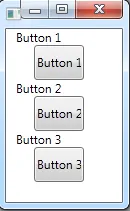注意:我正在使用Visual Studio 2012。
我有以下DataTemplate(注意:其中包含一个TextBlock和Button)。
第一次渲染视图时,每个按钮都会显示 Textblock,但按钮本身不会显示。如果我隐藏视图,然后再次显示它,有时按钮会出现(如果 CommandButtons 列表没有更改,则会出现,如果更改了,则永远不会出现)。在渲染视图后,我查看了输出窗口,没有绑定错误。我错过了什么?
我有以下DataTemplate(注意:其中包含一个TextBlock和Button)。
<DataTemplate DataType="{x:Type ctlDefs:myButton}">
<StackPanel>
<TextBlock Text="{Binding LabelText}" Margin="10,0,10,0"/>
<Button Content="{Binding LabelText}" Margin="0,0,10,0"
Width="{Binding ButtonWidth}"
Height="35"
Command="{Binding ButtonCommand}"
Visibility="Visible"
/>
</StackPanel>
</DataTemplate>
我的屏幕正在动态地将控件myButton添加到一个Items Control中
<ItemsControl ItemsSource="{Binding CommandButtons, Mode=OneWay}"
FlowDirection="LeftToRight"
DockPanel.Dock="Right"
>
第一次渲染视图时,每个按钮都会显示 Textblock,但按钮本身不会显示。如果我隐藏视图,然后再次显示它,有时按钮会出现(如果 CommandButtons 列表没有更改,则会出现,如果更改了,则永远不会出现)。在渲染视图后,我查看了输出窗口,没有绑定错误。我错过了什么?
 如果有用的话,我在下面附上了我的代码。注意:出于简洁考虑,我没有添加真正的ICommand对象,并且我不小心将MyButton类命名为大写M而不是像你的示例一样是小写m。
如果有用的话,我在下面附上了我的代码。注意:出于简洁考虑,我没有添加真正的ICommand对象,并且我不小心将MyButton类命名为大写M而不是像你的示例一样是小写m。